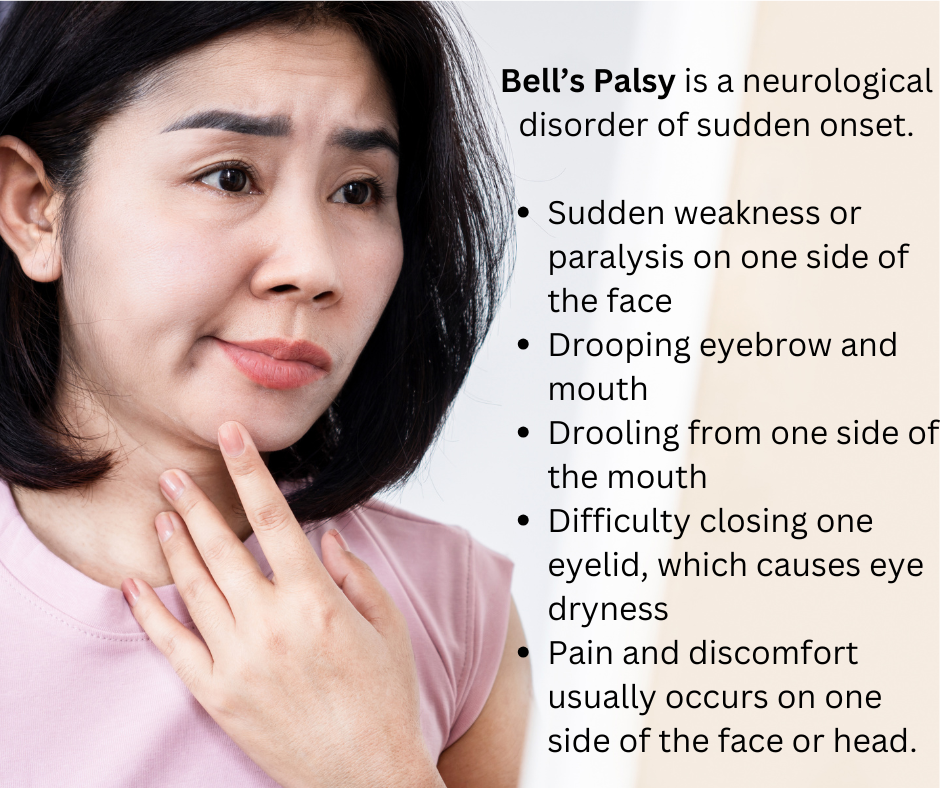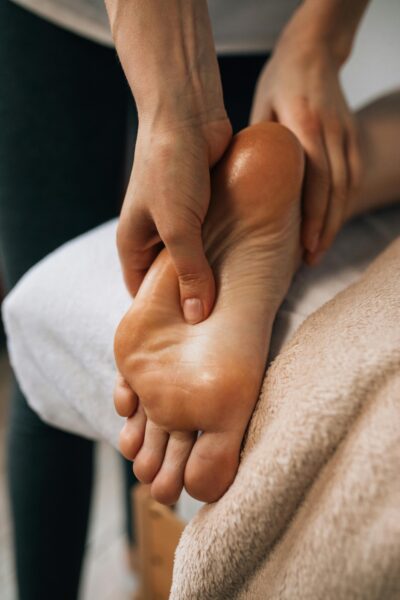If you’re searching for a holistic, natural approach to managing facial pain, acupuncture offers a compassionate path toward lasting relief and improved well-being. We’re here to support you with personalized care, helping you discover how acupuncture can be an essential part of your pain management journey.
Facial pain can disrupt every aspect of life—work, relationships, and even sleep. Whether it stems from nerve issues, muscle tension, or inflammation, the constant search for relief is exhausting. Acupuncture, rooted in Traditional Chinese Medicine (TCM), offers a drug-free approach that addresses the deeper causes of pain, making it an effective option for a range of facial pain conditions, including Bell’s Palsy, Trigeminal Neuralgia, TMJ, toothaches, and sinus pain.1
Acupuncture is a non-invasive, drug-free treatment that addresses both the symptoms and underlying causes of facial pain. It offers several advantages for those suffering from conditions such as Bell’s Palsy, Trigeminal Neuralgia, TMJ disorders, toothaches, and sinus pain:
- Holistic Approach: Acupuncture treats the whole body, focusing on restoring balance and harmony rather than merely addressing symptoms. This means that in addition to facial pain relief, acupuncture can improve your overall well-being.2
- Customizable Treatment: Each acupuncture session is tailored to your unique symptoms and needs. Acupuncturists will carefully select acupoints based on your specific condition, ensuring personalized and effective care.
- Minimal Side Effects: Unlike medications, which often come with side effects, acupuncture has minimal risks when performed by a licensed and trained practitioner. It is a safe option for people who cannot tolerate pain medications or prefer a natural approach.
- Collaboration with Other Healthcare Providers: Acupuncture can be used alongside conventional treatments, such as physical therapy, medications, or dental care. Many healthcare professionals, including dentists, neurologists, and pain specialists, recommend acupuncture as a complementary therapy for managing facial pain.3
How Acupuncture Works for Facial Pain
Acupuncture stimulates specific points on the body to regulate the flow of energy, often called “qi.” In TCM, pain is seen as a result of blockages or disruptions in this flow. By inserting ultra-thin, sterile needles into targeted points, acupuncture can restore balance, reduce inflammation, and activate the body’s natural healing abilities. This approach goes beyond temporary relief—it promotes overall physiological balance and pain management. Scientific research has shown that acupuncture stimulates the nervous system, releases endorphins (the body’s natural painkillers), improves blood flow, and relieves muscle tension—key factors in alleviating pain.4
Relief for Sinus Pain
Sinus pain, often due to inflammation or congestion, brings discomfort around the nose, eyes, and forehead, especially during allergy season. Chronic sinusitis sufferers know how deeply this pain can affect daily life.

Many patients report feeling immediate relief after acupuncture for sinus pain, as the treatment helps open the nasal passages, allowing for easier breathing and reduced pressure in the sinuses.5 Studies suggest that acupuncture may relieve sinus-related pain by modulating the nervous system, improving circulation in sinus areas, and even influencing immune responses, which can reduce the frequency and severity of sinus infections.6 Some evidence also indicates that acupuncture may help reduce sinus headaches and improve the overall quality of life for individuals with chronic sinusitis.7
Supporting Recovery from Bell’s Palsy
If you have even had Bell’s Palsy, you know you would do anything to speed up recovery. Bell’s Palsy comes on suddenly, worsens over the course of a couple of days, and can take several months to recover. When it happens, one side of the muscles in your face may droop, creating an asymmetrical face. You may have trouble closing one eye, smiling equally from side to side, or puffing out one cheek. It is also common to have tearing of one eye, headaches, and drooling. Pain or discomfort on the affected side of the face is also common.
While the cause of Bell’s Palsy is unknown, the result is inflammation and involvement of the seventh cranial nerve, often occurring after a viral infection and sometimes during or after pregnancy.8 Treatments may include steroids, antivirals, and medications to help the symptoms (such as eye drops for dry eyes); but ultimately, it just has to run its course.
Acupuncture is commonly used as an adjunct therapy to gain muscle function back sooner, decrease pain, and treat the underlying cause by strengthening your immune system and helping your body to regain homeostasis. The findings of a 2015 systematic review and meta-analysis suggest that acupuncture can be effective in improving recovery outcomes, especially when compared to conventional treatments alone, and showed statistically significant improvements in facial nerve function and higher recovery rates in patients treated with acupuncture.9

Acupuncture can support recovery by reducing inflammation, improving circulation to the affected area, and promoting nerve regeneration. Studies have shown that acupuncture significantly improves facial muscle function and symmetry, potentially speeding up recovery and lessening long-term complications such as atrophy and drooping of facial muscles. While Bell’s Palsy often resolves on its own, acupuncture offers a faster path to feeling—and looking—like yourself again.10
Managing Trigeminal Neuralgia with Acupuncture
Trigeminal Neuralgia brings severe, stabbing pain along the trigeminal nerve, causing sudden, intense, and debilitating pain in the face. This pain can be triggered by everyday actions like chewing, talking, or even touching your face.
Acupuncture offers a safe, drug-free alternative for managing Trigeminal Neuralgia. By calming the nervous system and reducing inflammation, acupuncture can help reduce the frequency and intensity of these painful episodes. Research shows that acupuncture can significantly lower pain levels and attack frequency, offering lasting relief and improving quality of life for those with this challenging condition.11
TMJ Pain and Acupuncture
Temporomandibular joint (TMJ) disorders lead to jaw pain, stiffness, and dysfunction, affecting eating, speaking, and even smiling. It’s often accompanied by headaches, earaches, and neck pain.
Acupuncture can be highly effective in relieving TMJ pain by relaxing jaw muscles, reducing inflammation, and restoring normal joint function. By improving blood flow and targeting related muscles, acupuncture not only eases jaw pain but also helps alleviate associated headaches and neck pain. A recent clinical trial confirmed that acupuncture can significantly improve jaw movement and reduce pain for TMJ sufferers.12

Complementary Relief for Toothaches
From mild discomfort to sharp, throbbing pain, a toothache can disrupt your life. While dental care is essential for addressing the cause, acupuncture can provide complementary relief by reducing pain and inflammation.
Acupuncture promotes blood flow to the affected area, stimulating the body’s natural pain-relief responses. It’s also known for easing the stress and tension that often accompany dental pain. Studies suggest that acupuncture may help manage acute dental pain and even enhance the effectiveness of local anesthesia, offering a well-rounded approach to managing tooth pain.13
Final Thoughts
Living with facial pain can significantly impact your quality of life, but acupuncture offers a non-invasive approach to managing and providing lasting relief from pain and discomfort. Whether you’re dealing with Bell’s Palsy, trigeminal neuralgia, TMJ, a toothache, or sinus pain, acupuncture can help reduce pain, promote healing, and restore balance in the body. By targeting specific acupoints to reduce inflammation, relieve muscle tension, and stimulate the body’s natural healing mechanisms, acupuncture not only addresses pain but also promotes overall physiological balance. This traditional method can be a valuable component of a comprehensive pain management plan, particularly for those seeking alternatives to medication or invasive procedures. As research continues to support its effectiveness, acupuncture stands out as a powerful, integrative option for relieving facial pain and improving quality of life.
Written by Whitney Patterson, edited by Erin Pass
Sources:
- Öksüz CE, Kalaycıoğlu A, Uzun Ö, et al. The Efficacy of Acupuncture in the Treatment of Bell’s Palsy Sequelae. J Acupunct Meridian Stud. 2019.
- Li P, Qiu T, Qin C. Efficacy of Acupuncture for Bell’s Palsy: A Systematic Review and Meta-Analysis of Randomized Controlled Trials. PLoS One. 2015.
- National Institute of Neurological Disorders and Stroke. Bell’s Palsy. NIH, 2024.
- American Association of Neurological Surgeons. Trigeminal Neuralgia.
- Ang L, Kim HJ, Heo JW, et al. Acupuncture for the Treatment of Trigeminal Neuralgia: A Systematic Review and Meta-Analysis. Complement Ther Clin Pract. 2023.
- Edwards JW, Shaw V. Acupuncture in the Management of Trigeminal Neuralgia. Acupunct Med. 2021.
- Liu L, Chen Q, Lyu T, et al. Effect of Acupuncture for Temporomandibular Disorders: A Randomized Clinical Trial. QJM. 2024.
- Müller M, Schmucker C, Naumann J, et al. Acupuncture in Management of Acute Dental Pain – A Systematic Review and Meta-Analysis. Jpn Dent Sci Rev. 2023.
- Lee B, Kwon CY, Park MY. Acupuncture for the Treatment of Chronic Rhinosinusitis: A PRISMA-Compliant Systematic Review and Meta-Analysis. Evid Based Complement Alternat Med. 2022.
- Patil SP, Mangalgi A, Kashetty



